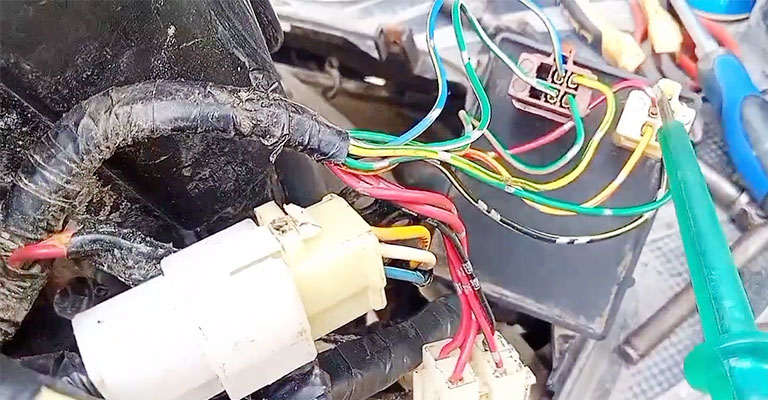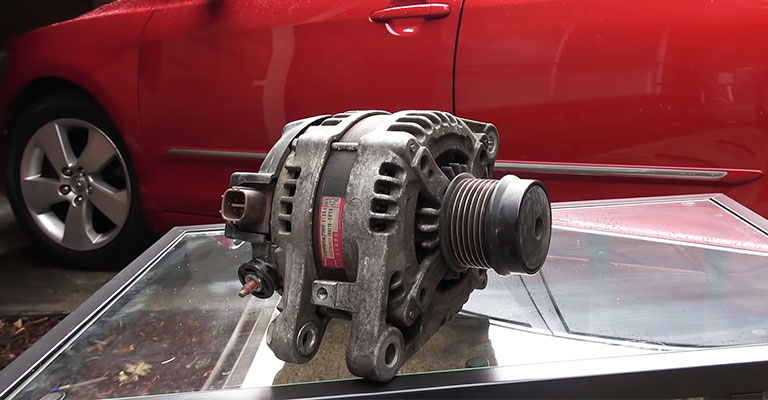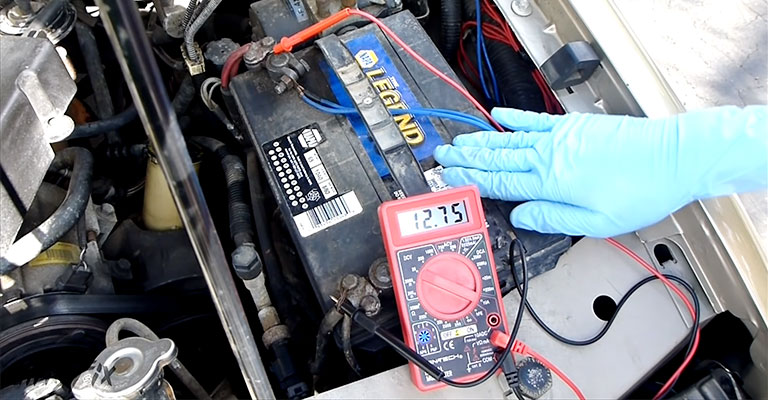You cannot operate your vehicle without a charging system. Electrically powered or controlled components have replaced many mechanical components.
As vehicles have become much more complex, the battery charging system has become essential to keep everything running smoothly. The charging procedure can, however, be affected by many things, like a bad battery or alternator.
Charge system issues need to be addressed as soon as they are detected. There is also the possibility of being stranded with a car that doesn’t run or start.
Possible Causes Of Charging System Failure
An alternator is a part of a charging system, along with a battery and a voltage regulator. Charging systems operate the vehicle’s electrical accessories and maintain the battery’s state of charge.
A charging system failure can be caused by the failure of any one of these three parts. Some causes of faulty charging systems in cars are listed below.
1. Belts That Are Damaged Or Worn Out

An alternator belt that is worn so badly that it slips is one of the problems that can cause the charging system to fail.
A properly functioning alternator can drop voltage output if the belt does not spin fast enough. Therefore, you may not notice the belt breaking immediately if it happens while driving.
Unlike older cars, newer cars use one belt to drive everything, so you may notice your car overheating, warning lights on the dash, or heavy steering if none of the accessories are working.
2. Wiring
Wires connect the battery and alternator so that damaged wires can lead to voltage loss. Dirty terminals are no different. Charging and discharging problems can also be caused by bad ground connections.

3. Bad Alternator
It isn’t uncommon for alternators to work for many years before needing to be replaced, but some things can go wrong with them that may lead to their failure. A bad voltage regulator is the most common culprit. Alternators produce electricity, which a voltage regulator inside the unit controls.
If the alternator did not have control over the twelve-volt system, the car could produce much higher voltages. In addition, a faulty voltage regulator can cause an overvoltage condition, damaging the battery and other parts of the car.
Alternatively, a bad voltage regulator may limit the voltage too much, preventing the battery from fully charging and leaving the rest of the electrical system unpowered.
If the alternator fails to produce enough power while you are driving at night and the headlights are on, the battery will provide additional power for your car’s lights and ignition system.
An undercharged or dead battery is the result of this situation. A professional should check the alternator for proper operation and replace it if necessary.

4. Belts That Are Damaged Or Worn Out
Motors power alternators. A worn drive belt will prevent an alternator from turning or slowly turning it. In addition, fan belts often slip because of hardening or glazing. If a belt slips, there may be a problem with the fan belt tensioner or worn bearings on other pulleys.
5. Having A Dead Battery
A dead battery is perhaps the most common indication of a charging system problem. Therefore, it is likely that you will need to determine the cause of the problem first. It is possible that an old battery no longer holds a charge, for example.
An automotive battery typically lasts between two and five years, so you may need to replace it if it is older than that. It’s not hard to test the battery, but if you can get it to a parts shop that offers free testing, you’ll get a full load test and report on its condition and won’t have to guess whether it’s bad.
Check the connections on the alternator and battery if the battery tests fine. Low charge conditions can happen when the terminals are corroded, reducing their conductivity.

6. Electronic Control Unit (ECU)
If the ECU fails or isn’t working properly, the vehicle’s electrical system will not operate correctly. If your vehicle’s ECU fails, you may have a lot of problems as a result.
To operate properly, the alternator requires information regarding electrical supply and demand. A malfunctioning ECU can cause a charging system to fail. Nonetheless, you would want to rule out the other possibilities since they can be the hardest and most expensive to fix.
The alternator charging voltage can be read out live using an OBD II reader, and some provide live readings. However, the ECU can be damaged if the jump-start procedure is incorrect.
7. Power Outage

When a vehicle’s motor is off (not generating power), anything that draws power may affect the vehicle. For example, the headlights, radio, air conditioner, or the sneaky glove box light may generate power.
The same is true for some aftermarket radio components, which can draw too much power when the motor is running. The battery charge can be drained by either of these, causing the vehicle not to be able to be restarted.
Diagnosing A Charging System Problem
If your battery charging system fails, you cannot create or retain a charge in your car. There are several causes of this problem, but the most common one is a bad alternator.
You may also experience a mechanical problem in your cars, such as a loose serpentine belt or a problem with its electrical system. Before taking your vehicle to a mechanic, here’s a quick diagnosis you can make.
1. Check It Out Visually
Make sure the battery is corrosion-free, and there are no loose wires. Likewise, ensure that the alternator’s wires are not loose. The alternator should also be checked for water or oil leaks.
2. Use A Multimeter
The output voltage of the alternator can be tested with a multimeter while the motor is running. Regardless of how much the motor is revved, it should only fluctuate between 13 and 14.5 volts.
The fusible link and alternator fuse should be checked if it is not charging at all. There might be a problem with the brushes or rotor in the alternator if the fuses are fine, but there is still no charge. An out-of-parameter value indicates a failure of the regulator.
3. Check The Wiring
Measure the battery terminals while the motor is running. A power drop of no more than 0.20v should be observed compared to what you measured at the alternator.
The cause of a drop of more than that can be damaged wires, the wiring feeling warm, and the plastic coating being brittle. It is also possible that the grounds (wires mounted to the vehicle body) are corroded and tightened incorrectly.
4. Check The Battery
We move on to the battery if the wiring is fine. Connectors should be tight, and terminals should be free of buildup. There shouldn’t be any excessive heat coming from the battery. Make sure the headlights are on when measuring the battery voltage. Around 12.5 volts should be present.
5. Keep An Eye Out For Warning Lights
You may notice warning lights on your dashboard if your alternator isn’t charging. A flickering radio screen, heavy steering, hard shifting or no shifting, dimming lights, and electronically assisted steering may be signs you need to get started. Battery power will gradually decrease, causing this problem to worsen.
How Does A Car Battery Charging System Work?
It consists of two main components; it generates, stores, and spreads electrical energy for use by the vehicle’s many components. A battery stores the electrical energy generated by the alternator, which is constantly in use.
Engine power turns the alternator using serpentine belts, also called fan belts, running around a series of pulleys. Basically, it’s turned by the crank pulley on the crankshaft, which rotates because of the internal combustion.
Then, it turns mechanical energy into electrical energy by rotating the alternator pulley. It’s necessary to regulate the alternator’s output to avoid overcharging the battery because it’s directly tied to the engine’s RPM.
Charging System Failure Caused By A Bad Battery?
Even a healthy alternator can’t start your vehicle if the battery can’t store the energy. Even with a dead battery, you can still drive until the vehicle is halted, but some electrical components might malfunction.
What Does A Service Battery Charging System Mean?
A car with a dead alternator means the ECU isn’t producing power, and the battery is the only power source. In the owner’s manual or a quick Google search, you can find the definition of the battery light or check the charging system light.
The light will illuminate when the ignition system is turned on, but once the vehicle is on and the alternator is charging, the light must be turned off.
An inspection will need to be conducted to narrow down the cause of the fault. For example, a loose alternator wire can cause the ECU to give a false reading, so check the wiring before spending lots of money on replacement parts.
The Bottom Line
If you have a keen eye, you may find a loose wire that only takes a few minutes to tighten. It doesn’t matter if you’re not mechanically inclined, you can now identify the root cause of a charging system failure light. As a result, the vehicle won’t explode so you can drive to a safe place with peace of mind.

Leave a Reply